Translate this page into:
Exploring the potential of green synthesized cerium oxide nanoparticles in mitigating chromium toxicity in maize
⁎Corresponding author. shafaqataligill@gcuf.edu.pk (Shafaqat Ali)
-
Received: ,
Accepted: ,
This article was originally published by Elsevier and was migrated to Scientific Scholar after the change of Publisher.
Abstract
Problem
Chromium (Cr) contamination in agricultural soils poses a significant threat to maize productivity and food security, necessitating the development of innovative strategies to enhance Cr tolerance and mitigate its toxic effects on plant growth and development.
Objective
The aims of current study are the green synthesis of cerium oxide nanoparticles (CeO2 NPs) using Jasminum officinale L. plant extract and their application to alleviate chromium stress in maize plants.
Methods
Fourier-transform infrared spectroscopy (FTIR), X-ray diffraction (XRD), scanning electron microscopy (SEM), energy dispersive X-ray (EDX), and elemental mapping methods were used to characterize the synthesized CeO2 NPs. The cerium oxide NPs (0, 25, 75 and 100 mg/L) treatment levels applied through foliar and seed priming to check growth, physiological responses and metal uptake by maize plants and a fully random design was used to set up a factorial experiment.
Results
The findings showed that foliar application of 100 mg/L CeO2 NPs resulted in an improvement in the plant height (43 %), shoot fresh plant (41 %) and root fresh weight (84 %), and total chlorophyll concentrations (67 %) in maize plants as compared to seed priming (as 25, 32, 40 and 43 % respectively). It also effectively enhanced antioxidant enzymes including super oxide dismutase (75 %) and peroxidase (79 %). In maize plants, by foliar application over the control, CeO2 NPs reduce electrolyte leakage (53 %), malondialdehyde contents (32 %), and chromium content in roots (70 %) under chromium stress.
Conclusion
Therefore, these results suggested that increase in the concentration of CeO2 NPs more efficiently 100 mg/L has high ability against chromium stress and act as a promising solution to reduce metal concentration, enhance maize growth and promote sustainable agriculture.
Significance
This study’s implications for future research on CeO2 NPs include elucidating their mechanisms in plant stress tolerance, exploring interactive effects with heavy metals, and expanding their use in plant stress management. Furthermore, this finding develops a novel strategy for improving maize cultivation in Cr-contaminated soils, contributing to sustainable agriculture and food security.
Keywords
Chromium
Cerium oxide nanoparticles
Maize growth
Plant stress response
Antioxidant enzymes
Environmental sustainability
- HMs
-
Heavy Metals
- HMT
-
Heavy metal Toxicity
- Zn
-
Zinc
- Cd
-
Cadmium
- As
-
Arsenic
- Cr
-
Chromium
- NPs
-
Nanoparticles
- CeO2
-
Cerium Oxide
- Ce (NO3)3
-
Cerium nitrate
- NaOH
-
Sodium hydroxide
- FTIR
-
Fourier-transform infrared spectroscopy
- EDX
-
Energy dispersive X-ray
- SEM
-
Scanning electron microscopy
- XRD
-
X-ray diffraction
- ROS
-
Reactive Oxygen Species
- MDA
-
Malondialdehyde
- POD
-
Peroxidase
- SOD
-
Superoxide dismutase
- EL
-
Electrolyte leakage
Abbreviations
1 Introduction
Soil contamination by heavy metals (HMs) is a serious environmental problem with significant effects. Anthropogenic activities such as mining, industrial operations, and agricultural practices cause heavy metal deposition in soil (Li et al., 2023). Metals are frequently non-biodegradable and persistent having the potential to affect ecosystems (Singh et al., 2022). Chromium (Cr), even at low exposure levels, presents significant toxicity risks to plants, soil, and human health (Mortada et al., 2023). There is substantial concern regarding the toxicity of Cr, especially hexavalent chromium (Cr (VI) to plants due to its detrimental effects on plant growth and development (Behrens et al., 2023). Through the roots, Cr enters the plant and mostly accumulates in the root system, resulting in stunted development, lower biomass, and decreased yield. In the rhizosphere, Cr induces stress that causes nutritional imbalances and shortages in the rhizosphere by interfering with absorption and transport of vital nutrients (Ali et al., 2023). Furthermore, Cr has the ability to alter the microbial population that is essential for controlling Cr speciation in the soil. The Cr gets transported to the plant's aerial parts after absorption by roots, where it interferes with physiological functions like photosynthesis and enzyme activity (López-Bucio et al., 2022). It also causes the production of reactive oxygen species (ROS), which damages cellular constituents by oxidative means and ultimately results in cell death (Saleem et al., 2022). In humans, chronic exposure to Cr compounds has been associated with skin irritation and respiratory problems, including a higher risk of lung cancer (Budi et al., 2024).
Application of nanotechnology has great potential in order to improve crop productivity and soil fertility for sustainable agriculture (Humbal and Pathak, 2023). The astonishing physicochemical characteristics of nanoparticles (NPs), such as their high specific surface area and thermal resilience, make them suitable for a variety of uses. For example, adsorbent materials, catalytic materials, nano-fertilizers and insecticides, and pollution sensors (Xu et al., 2023). With their targeted delivery and programmed self-regulation, the NPs offer multifunctional properties that allow for regulated release over specified periods. NPs can be used to change a plant's defense mechanism against metal stress and restrict extra trace elements (TEs) amount that plant absorbs (Ding et al., 2020).
Cerium oxide nanoparticles (CeO2 NPs) have several applications in agriculture, including disease treatment, promotion of plant growth, and improved nutrient management (Ayub et al., 2023). For the synthesis of CeO2 NPs, the green technique provides economical, non-toxic, and environmentally friendly option (Khan et al., 2023). The CeO2 NPs positively affect the development and growth of several crops. By enhancing the content of chlorophyll and adjusting the activity of photosynthetic enzymes, it can improve the efficiency of photosynthetic processes in plants. CeO2 NPs increase antioxidant activity, lessen the toxicity of heavy metals, and encourage the germination of seeds (Li et al., 2022). Maize (Zea mays L.) in Pakistan, among the most crucial strategic and staple crops, is widely grown crop along with rice and wheat. According to the Pakistan Economic Survey, 2022-23, maize production increased by 6.9 % to 10.18 million tones against last year's production of 9.52 million tones. It is being grown on an area of 1.016 million hectares with annual production of 3.037 million tons. Maize has amazing potential for soil–plant metal exchange, bioaccumulation, and plant extraction. Literature showed that Cr stress has a detrimental impact on maize growth.
This study explores the potential of CeO2 NPs as a tool for improving maize's tolerance to Cr stress. While the use of nanoparticles in agriculture is an emerging field, the specific application of CeO2 NPs to mitigate Cr toxicity in maize has not been extensively studied. Limited information available in the literature regarding the interaction between CeO2 NPs and Cr in plant uptake, indicating the need for more comprehensive studies in this area. The study will provide insights into the interactive effects of Cr and CeO2 NPs on various growth parameters, photosynthetic efficiency, and Cr uptake in maize. Here, we hypothesized that green synthesized CeO2 NPs will lessen/ameliorate Cr toxicity in maize plants and positively improve growth attributes, therefore overall enhancing plants health and reduce metal stress. The aims of this study were to evaluate the effects of foliar and seed priming applied CeO2 NPs on maize growth attributes, antioxidant capacity as well as Cr uptake by plants under chromium stress.
2 Materials and methods
2.1 Synthesis and characterization of CeO2 NPs
Fresh jasmine (Jasminum officinale L.) flower leaves were collected from the Government College University Faisalabad Botanical Garden. The flowers were first cleaned with tap water and then again with distilled water to remove any potential contaminants before extraction. Afterward dried for 48 h at 40 °C in a hot air oven. Solvent extraction was carried out using the powder that was produced after the dried leaves were crushed and sieved. A 0.1 M solution of cerium nitrate (Ce (NO3)3 was prepared in 50 mL of water by using a flask. Then 20 mL of prepared flower extract was added in cerium nitrate solution drop by drop and the mixture was stirred thoroughly for approximately 6 h on a hot plate. After 6 h of continuous stirring the solution was taken off from the hot plate and let it stabilize for around 24 h. After stabilizing, the solution is collected in falcon tubes and then placed in a centrifuge machine at specific revolution speed for 30 min. Required NPs were obtained at the bottom of falcon tubes and then placed at room temperature. Obtained NPs with distilled water were washed for purification and further calcination of obtained NPs done with microwave oven.
Fourier-transform infrared spectroscopy (FTIR) examination was carried out by using a spectrometer (Thermo-Nicolet 6700 FTIR spectrometer) in the range of 400–4000 cm−1 to study the surface functional groups of synthesized CeO2 NPs (Das et al., 2022). X-ray diffraction and scanning electron microscopy (SEM) analysis were used to characterize the produced CeO2 NPs' crystal structure as well as their physical and chemical properties. Particle size calculations were carried out with the aid of Debye-Scherrer's equation (Irshad et al., 2020).
2.2 Soil sampling and pot experimental design
The experiment's soil collected from the Kasur, Pakistan, that had previously been irrigated with raw tannery wastewater contaminated with heavy metals. Using a stainless-steel shovel, random soil samples were obtained between 0 and 20 cm deep. To ensure homogeneity, the samples were then thoroughly mixed. To ensure consistent particle size, the collected samples were then air-dried without exposure to sunlight and put through a 2 mm sieve. After that, various soil parameters were checked by using standard methods as described by (Sarkar, 2005), and chromium content (Lazo, 2009).
For the experiment, plastic pots were used, and everyone contained 5.0 kg soil contaminated with Cr, and initially eight healthy and evenly sized maize seeds were planted in every container. The experimental setup was randomized in its design. After 15 days of seeding, the plants were thinned to 5 seedlings per pot. Concerning exposure to CeO2 NPs, half of the containers underwent foliar spraying at varying intervals with CeO2 NPs levels of 0, 25, 50, and 100 mg L-1, using Tween-20 as an adhesive agent. Additionally, the remaining containers were subjected to seed priming with the same treatment levels. For seed priming, the maize seeds were sterilized for two minutes in a sodium hypochlorite solution containing 2.6 % active chloride. The chloride content was then carefully removed by washing the seeds with deionized water. CeO2 NPs at various concentrations (0, 25, 50, and 100 mg/L) were made. Afterward, seeds were soaked in NPs prepared solution for 20 h in dark. At the same time, control groups seeds were primed by using deionized water. Finally, for the further experiment, primed seeds were dried and keep in storage at 4 °C (Hussain et al., 2019). The initial foliar spraying occurred right after plant thinning, specifically between 10 and 11 am. During the application of CeO2 nanoparticles through foliar spraying, shield the potted soil to prevent particle deposition on its surface. Furthermore, each container received NPK fertilization. Soil moisture content was consistently maintained at 70 percent of its water retention capacity throughout the entire growth period. With the usage of an Infra-Red Gas Analyzer, photosynthetic rate, stomatal conductance, and transpiration rate were assessed.
2.3 Plants harvesting
When the plants were fully mature, harvesting was completed. For further study, the plants' various components, including roots, shoots, and leaves, were separated after being cut from the earth at a height of around 1 cm. With distilled water, the plant's shoots and roots were thoroughly cleaned. The roots were then thoroughly washed with filtered water after being rinsed with a 1 % hydrochloric acid (HCl) solution.
2.4 Plant growth attributes and chlorophyll content
Following harvest, measurements were carried out on the plants' heights using measuring tapes while weight balance determined dry weights of shoots and roots. Leaf area (cm2) was also calculated. For chlorophyll (a, b and total) and carotenoid analysis, fresh leaves weighing 0.2 g were extracted in 0.5 ml acetone containing 3 % volume acetone. Absorption at specific wavelengths (663, 645 and 470 nm for chlorophyll a, b, and carotenoid, respectively) was assessed with a spectrophotometer after centrifuging the sample for 10 min at 10,000 revolutions per minute as outlined by earlier studies (Lichtenthaler, 1987; Gohari et al., 2020).
3 Assessment of antioxidant enzymes and oxidative stress
The antioxidant activity of the enzymes was determined using established protocols. The method described by Aebi (1984) was followed in order to measure the activity of catalase. Ascorbate oxidase quantified by following Nakano and Asada (1981), peroxidases and superoxide dismutase activities by Zhang, (1992). By examining the levels of H2O2, MDA, and EL in maize plants, ROS level was quantified. The first EC1 was obtained by extracting the supernatant after autoclaving at 32 °C for two hours, then heating the sample at 121 °C. By using the methodology given by Dionisio-Sese and Tobita, (1998), the final EL contents were noted. A 0.1 gramme plant sample was crushed in liquid nitrogen to obtain the supernatant solution, that then added to a 0.05 M phosphate buffer to determine the concentrations of H2O2. To quantify MDA, 0.1 % concentration of trichloroacetic acid (TCA) and 0.5 % thiobarbituric acid (TBA) concentration were combined to make a supernatant solution.
The absorbance at 532 nm was then measured (Zhang and Kirkham, 1994). The method described by Jana and Choudhuri, (1981) was used to calculate the concentration of H2O2 and measuring its absorbance at 410 nm.
3.1 Chromium concentration in shoots and roots
The standard acid digestion procedure, as outlined in APHA (2012), was used to determine the Cr content in plant roots and shoot samples. Samples of roots and shoots weighing 1 g each were ground and subjected to acid digestion using a 3:1 ratio of HNO3 and HCLO4. With the help of atomic absorption spectrophotometer (AAS), the metallic contents were subsequently analyzed in the digested samples.
3.2 Data analysis
Data was analyzed with SPSS Statistics for Windows, Version 21.0 to determine the significance of differences among treatment groups applied at 5 % level of probability using analysis of variance (ANOVA). Additionally, for mean comparisons, we utilized Tukey's HSD post hoc analysis.
4 Results
4.1 Cerium oxide nanoparticles characterization (FTIR, XRD, SEM, EDX mapping)
Green nanoparticles made with jasmine extract were characterized using a variety of methods. The link between the different functional groups found in plant extract was investigated using FTIR (Fig. 1). Peaks at 3297, 2900, 2118, 1981, 1633, 1378, and 1016 cm−1 were visible in the spectra of the cerium oxide nanoparticles. The extensive absorption seen in the range of 3000–3297 cm−1 is due to the stretching vibration of O–H bonds, arising from residual alcohols, water, and Ce-OH groups. The existence of CeO2 NPs is confirmed by the peak absorption at 3297 cm−1.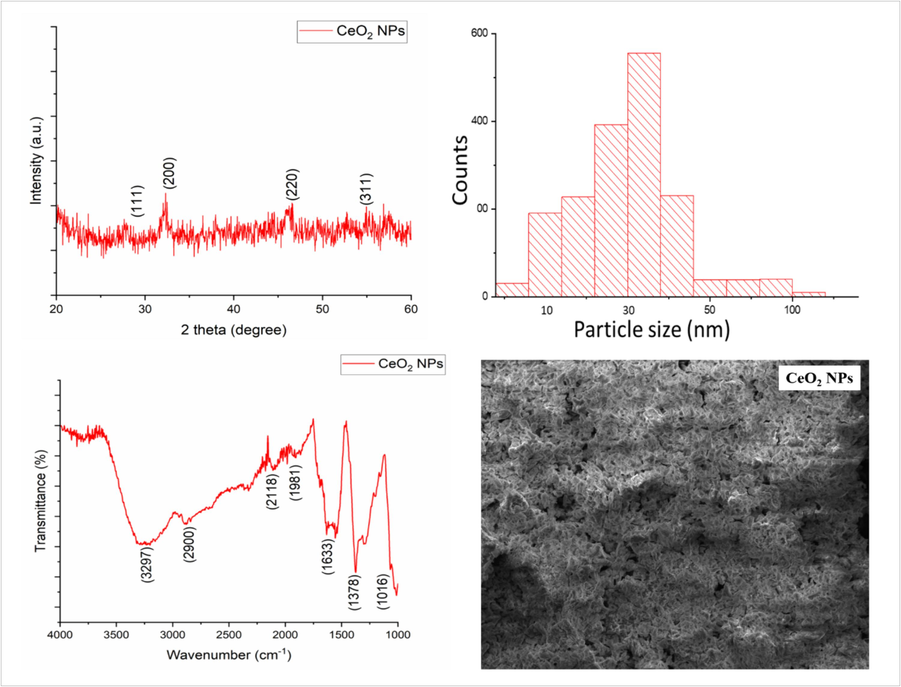
Data demonstrated (a) XRD analysis (b) mean particle size (c) FTIR absorption peaks of synthesized CeO2 NPs and (d) SEM analysis to show the surface morphologies of CeO2 NPs.
Furthermore, CeO2 NPs FTIR spectra, a distinctive peak at 2900 cm−1 was observed, indicating the presence of alcoholic and water groups. The CeO2 NPs synthesis from jasmine leaf extract was suggested by the 1016 cm−1 band, which reflects the vibrations caused by the stretching of Ce-O bonds. The CeO2 NPs made using plant extract in a green way may have a variety of functional groups overall. Fig. 1 depicts the results of an X-ray diffraction examination used to examine the shape and crystallinity of CeO2 NPs. The XRD data demonstrated that synthesized NPs exist in face-centered structure as confirmed by peaks found at 2 h angles. The CeO2 NPs' XRD pattern displays a number of peaks at angles (2θ) of 28.58, 33.06, 47.33, and 56.53, which are equivalent to the (1 1 1), (2 0 0), (2 2 0), and 311 planes of the CeO2 NPs, respectively. The Debay-Scherrer formula (D = 0.94/1/2cos) had been utilized to determine the crystallite dimensions and size parallel to the reflecting planes. The synthesized cerium NPs particle size was found 30–35 nm.
With respect to surface morphology characteristics and form fluctuations of CeO2 NPs, SEM technique was used in addition to XRD. Both solitary and aggregate spherical nanoparticles were found in the SEM investigation (Fig. 1d). Surfaces (both smooth and rough) have been found on green synthesized NPs, providing a variety of active areas that made them useful for tackling different environmental problems. Spot analysis, EDS elemental mapping, and SEM-EDX were used to assess the elemental composition and co-occurring elements in green produced CeO2 NPs. The Ce is present throughout the material, as shown by the purity of S1 and S2 in the EDX spectrum of CeO2 NPs, which was 49.31 % and 45.31 %, respectively (Fig. 2). Fig. 3 shows the outcomes of the SEM-EDX analysis and EDS mapping procedures, which provide light on the material's purity. The research confirmed the amalgamation of CeO2 NPs by the jasmine plant extract by detecting cerium (Ce) and oxygen (O) in the samples at quantities of 23 % and 36 %, respectively. A trace quantity of carbon (C) from the carbon tape slide that was used to prepare the sample was found in the SEM examination. Additional proof of Ce's existence was supplied by the related EDS spectra and EDS maps.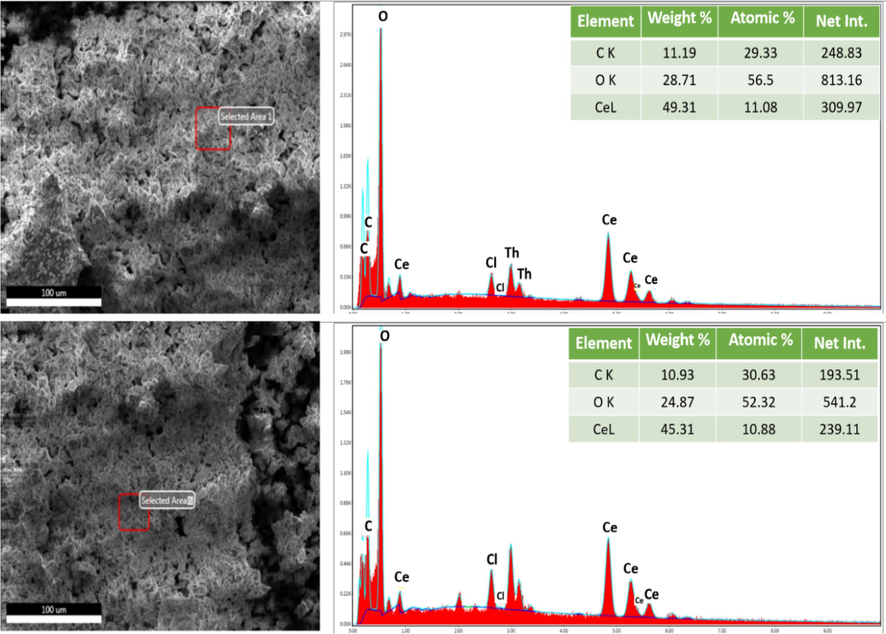
Demonstration of the EDX spot analysis of the CeO2 NPs produced by the Jasminum officinale L. plant extract.
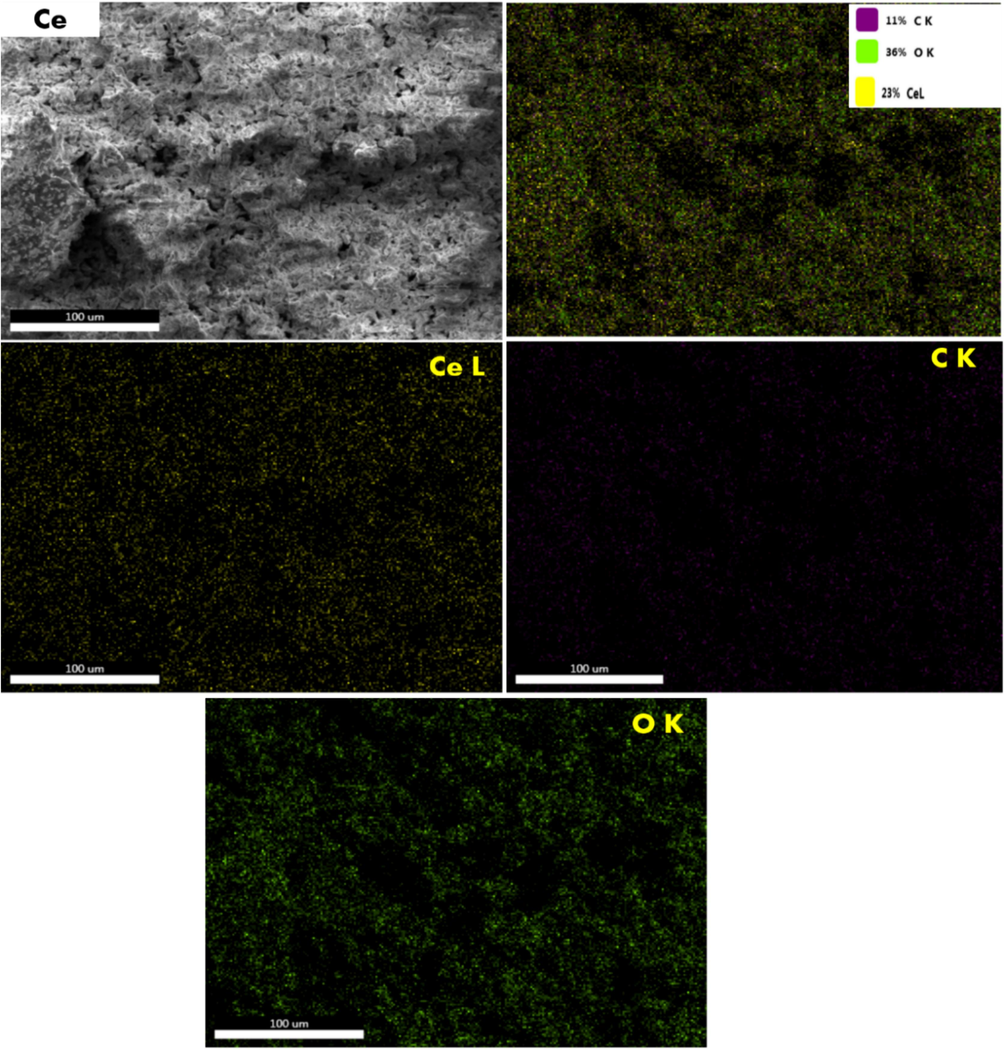
Illustrated the CeO2 NPs detection using EDX mapping method that produce utilizing a green approach by Jasminum officinale L. extract. (For interpretation of the references to colour in this figure legend, the reader is referred to the web version of this article.)
4.2 Effect on plant growth and photosynthetic parameters
Fig. 4 a–f show that all plant growth indices were considerably enhanced with increasing CeO2 NPs concentration from 25 to 100 mg L-1. As compared to the control group, several foliar and seed priming application treatments revealed variance in all growth characteristics. Maximum increases in the root dry weight (55 %), root fresh weight (84 %), shoot dry weight (69 %) and plant height (43 %) were observed at 100 mg L-1 NPs foliar apply as compared to control. For priming, maximum root dry weight (57 %), shoot dry weight (58 %) and plant height (25 %) were observed in the 100 mg/L CeO2 NPs treatment.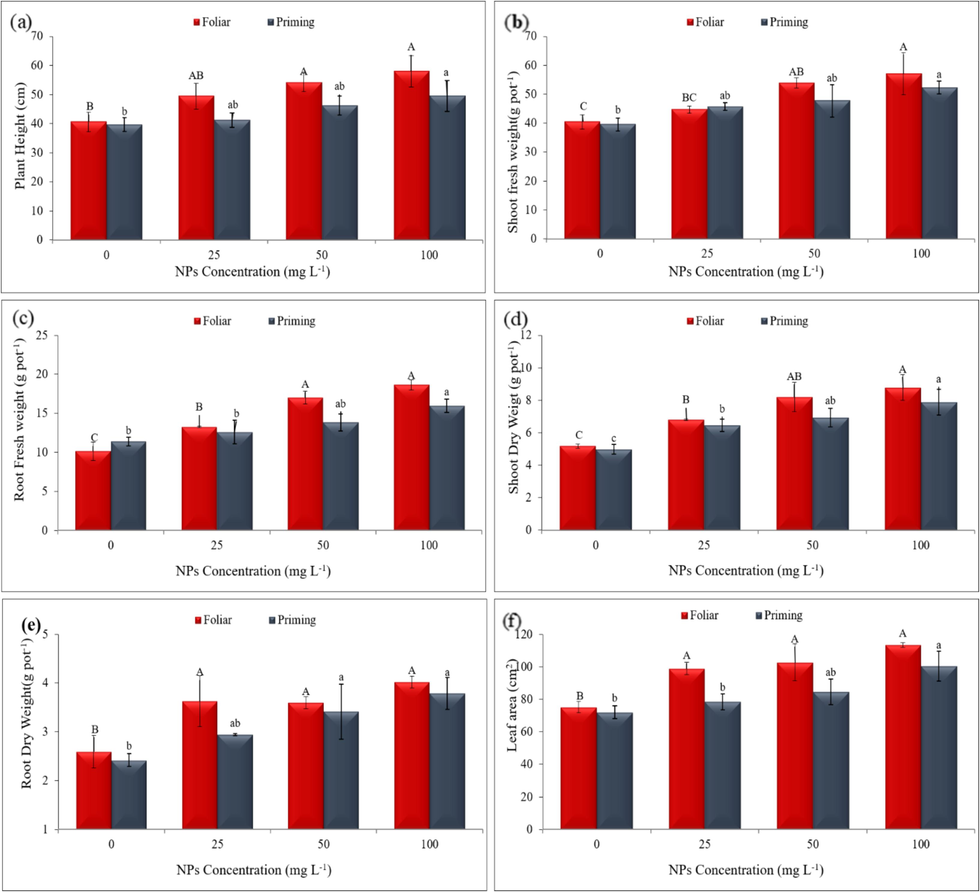
Comparison of (a) plant height, (b) shoot fresh weight, (c) root fresh weight, (d) shoot dry weight, (e) root dry weight, and (f) leaf area under two foliar and seed priming CeO2 NPs applied mode. Significance distinctions among concentration levels are denoted by diverse letters on bars, having significance threshold set at a P-value of less than 0.05.
The photosynthetic parameters under several CeO2 treatments at 25, 50, and 100 mg/L are shown in Fig. 5A–D, respectively. The control group has the lowest chlorophyll quantities in both foliar and priming NPs application modes. This demonstrates that the elevated Cr concentration used as the control significantly decreased the rate of photosynthesis and transpiration, stomatal conductance, and water usage efficiency in maize, much as Cr stress did on growth attributes. The exogeneous application of CeO2 NPs suggestively increases the photosynthetic parameters in maize plants. Through foliar, an increase in chlorophyll concentration was seen by 25, 45, 71 %, while chlorophyll b increased by 23, 34, 59 % and carotenoid by 23, 43, 58 %, at 25, 50 and 100 mg/L treatment, respectively as compared with the control.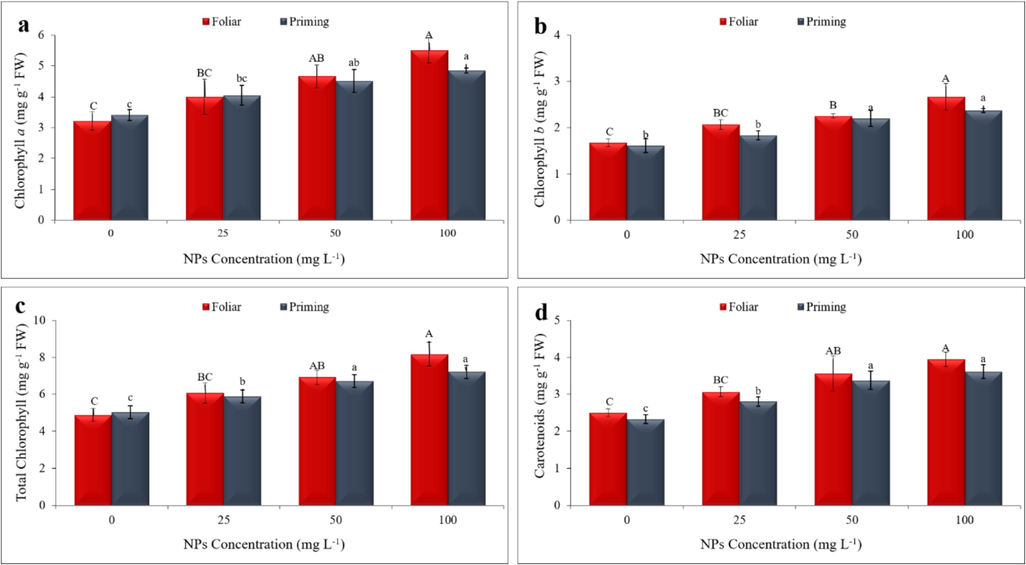
Data represents (a) chlorophyll a, (b) chlorophyll b, (c) total chlorophyll, (d) carotenoid under CeO2 NPs application by foliar and seed priming at various concentrations along with control group. Each bar in the graph is accompanied by a vertical line representing a standard error bar.
When CeO2 NPs were applied via foliar at the 100 mg L-1 treatment as compared to seed priming, the maximum increase in photosynthetic rate (66 %), stomatal conductance (73 %), transpiration rate (44 %), and water usage efficiency (77 %) were seen. However, seed priming with CeO2 NPs also greatly increased the photosynthetic properties compared to the control, with foliar mode showing the greatest efficiency. When comparing to foliar, seed priming also significantly increased photosynthetic rate (12, 31, 51 %), transpiration rate (3, 24, 36 %) and stomatal conductance (36, 45, 66 %) at 25, 50 and 100 mg/L, respectively. The increase in gas exchange parameters was directly proportional to the concentration of CeO2 NPs applied (Fig. 6).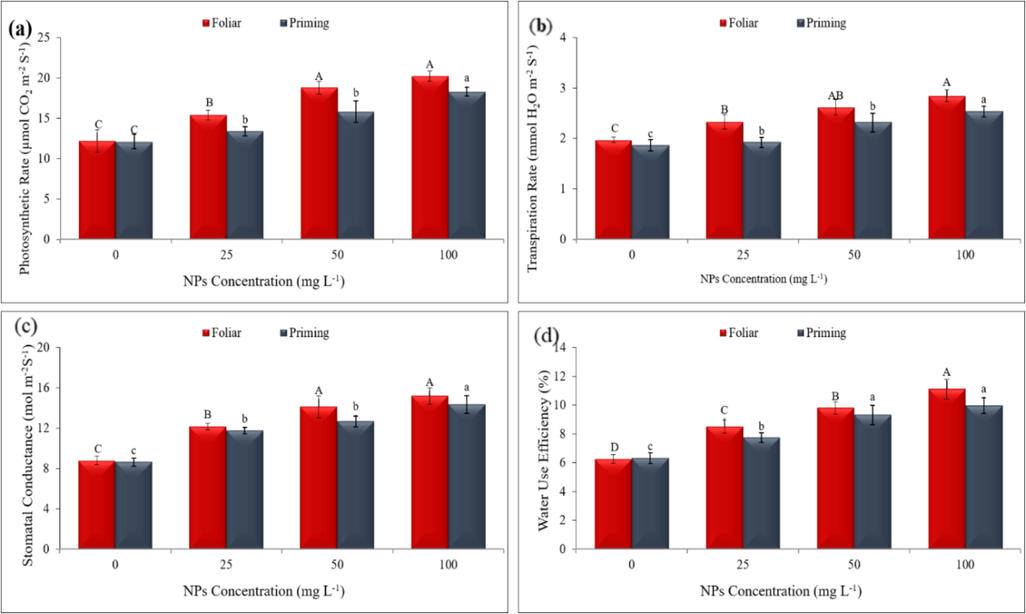
Data shows (a) photosynthetic rate, (b) transpiration rate, (c) stomatal conductance, (d) water use efficiency. Each bar in the graph is accompanied by a vertical line representing a standard error bar.
4.3 Effect on oxidative stress and enzyme activities
The impact of employing green-synthesized CeO2 NPs through foliar and seed priming application on enzyme activity parameters was assessed, focusing on SOD, POD, CAT, and APX in maize plants (Fig. 7 a-f). The application of CeO2 NPs demonstrated a mitigating effect on chromium-induced stress, leading to an enhancement of enzymatic activity in the plants under such stress conditions. The overall finding showed that foliar application of CeO2 NPs boosted antioxidant enzymes in maize plants under chromium stress as compared to priming. For instance, when CeO2 NPs concentration was elevated (25 to 100 mg L-1) through foliar route, SOD activity in plants increased by 40 to 75 % as compared to control group. In maize, seed priming with CeO2 NPs boosted SOD activity by 55 % above the control group at a 100 mg/L treatment dose.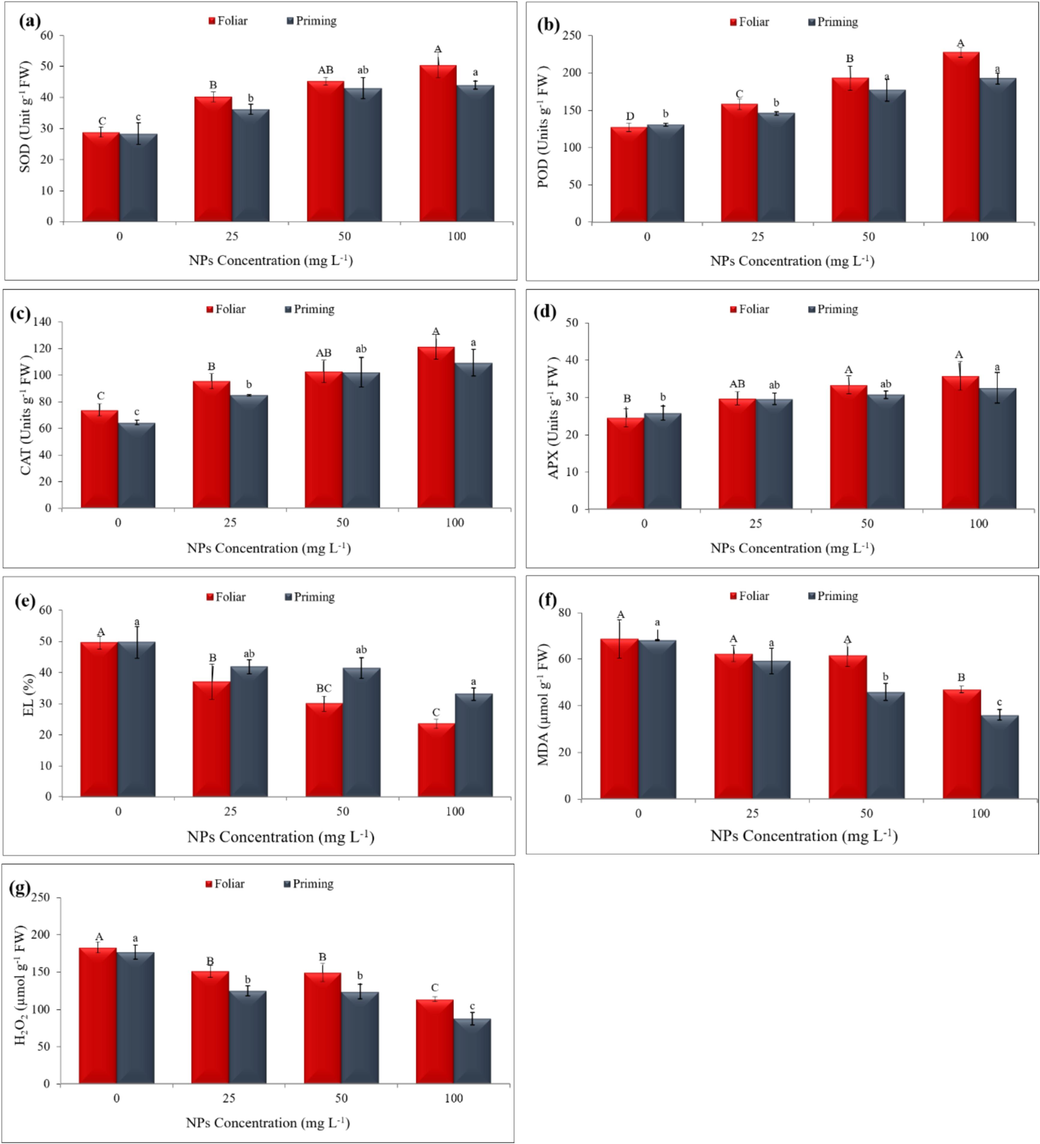
Shows effects on maize oxidative stress and enzyme activities parameters included (a) SOD, (b) POD, (c) CAT, (d) APX, (e) EL, (f) MDA, and (g) H2O2. Statistically significant differences among concentration levels are represented by different letters on the bars.
Increasing chromium concentration also enhances oxidative stress by increasing EL, MDA and H2O2 content in maize plants. The results (Fig. 7 a-c) show that CeO2 NPs at 25, 50, and 100 mg/L levels decreased EL content by 25, 40, and 53 %, respectively, compared to the control. The MDA levels decreased in maize leaves treated to various NP treatments. The MDA was decreased by 32 % when 100 mg L-1 CeO2 NPs were applied foliar rather than seed priming. Cerium NPs application also reduces oxidative stress by lowering H2O2 levels in plants. As it has been shown approximately on all applied treatment levels (25, 50, and 100 mg/L) by 17, 18, and 38 %, respectively by foliar and 29, 30, and 50 %, respectively, by priming.
4.4 Effect on chromium concentration in shoots and roots
Data regarding Cr uptake by roots and shoots have been demonstrated in Fig. 8 a-b. Cr concentration was high in both roots and shoots at control level. The CeO2 NPs significantly minimized the Cr concentration in roots and shoots. Individually, the greatest reduction in Cr concentration as 70 % and 78.3 % was found in roots and shoots respectively, when CeO2 NPs applied via foliar and 55 % and 63.3 % via seed priming at a dose of 100 mg/L. In comparison of foliar with seed priming, foliar significantly diminished the shoot and root Cr concentration more found as 16, 29 and 41 % in shoots and 15, 16 and 34 % in roots under 25, 50, 100 mg/L treatment levels, respectively.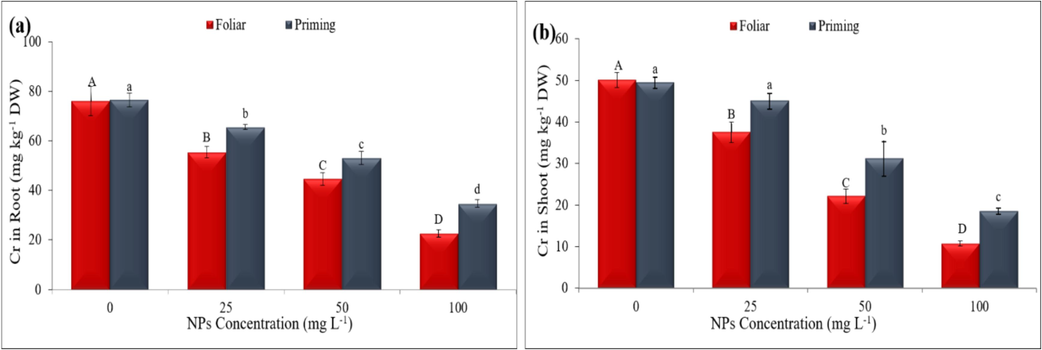
The effects of synthesized CeO2 NPs on maize chromium stress included (a) chromium in roots, (b) chromium in shoots. The CeO2 is applied by foliar and seed priming and variations among levels are shown by various letters indicated on bars.
5 Discussion
The findings obtained upon completion of the current study showcase the successful preparation of CeO2 NPs, highlighting their unique size and morphology. The XRD, EDAX, and FTIR are commonly used to characterize NPs optical and structural properties, as illustrated in Figs. 1 and 2. The XRD pattern of CeO2 NPs was also discovered by Mehmoodi et al. (2023) that support current study result, the crystallinity structure was a face-centered cubic (fcc), and the size was estimated to be 30 nm. The FESEM/TEM scans validated the NPs' spherical form. According to Das et al. (2022), CeO2 NPs samples exhibit a nanopolycrystalline structure with an average particle size of 70 nm. However, Miri et al. (2021) found that the synthesized CeO2 NPs varied in size from 4 to 13 nm.
Since leaf and flower extracts are abundant sources of metabolites, the majority of green synthesis research has been done on them so far (Nadeem et al., 2020). A number of additional plant extracts, including Dillenia indica (Das et al., 2022), Polygonum bistorta Linn (Khan et al., 2023), Cucurbita pepo (Mehmoodi et al., 2023), and Musa sapientum (Miri et al., 2021), have been used in literature to produce CeO2 NPs in an environmentally friendly manner. The unique capacity of Jasminum officinale L. extract to thrive under extreme environmental stressors makes it the perfect choice for use in the environmentally friendly synthesis of CeO2 NPs. It offers a sustainable and eco-friendly approach for various agricultural applications, including crop protection and stress mitigation.
Data collected also demonstrated that application of CeO2 NPs positively enhanced plant growth attributes under Cr stress (Fig. 4). High level of Cr in control group has a detrimental impact on the morphological parameters by disrupting water use efficiency, stomatal conductance, and photosynthetic processes. This finding also validates previous published literature that Cr stress in plants reduces transpiration, photosynthesis, and stunt growth (Ulhassan et al., 2022; Wyszkowska et al., 2022). On plants, effect of CeO2 NPs application varies as it depends on species; it can either be beneficial by enhancing photosynthesis through improvement of light-harvesting complex, or it can be harmful to some instance by inhibiting electron transport (Kataria et al., 2019). However, research has shown that plant-nanoparticles interactions are influenced by a variety of elements, including the NPs dose, size and soil type or condition (Lizzi et al., 2020). Abbas et al., (2020) findings suggest that 500 mg L-1 levels of CeO2 NPs increased plant development by stimulating photosynthesis, transpiration, and stomatal conductance in wheat. Higher NPs concentrations (2000 mg L-1 CeO2 NPs) have harmed plant development and photosynthetic processes. CeO2 NPs have gained attention for their potential in agriculture to improve stress tolerance in plants applied by foliar mode. The CeO2 NPs application through foliar route was found to be more significant in improvement of plant growth as compared to seed priming (Fig. 4). This finding correlated with Rasheed et al. (2022), as foliar application of CeO2 NPs can lead to higher photosynthetic rates in maize plants, promoting better energy production and overall plant health. The mechanisms underlying the interaction between CeO2 NPs and plants are complex and diverse. They may be absorbed by plants when applied to leaves and enter plant tissues via penetrating the leaf cuticle or by being absorbed through stomatal apertures. Instead, CeO2 NPs can enter vegetal tissues by penetrating through the root epidermal cell membranes when applied through roots. However, size inhibits CeO2 NPs from entering plant cells since membrane pores only open to a limited extent (Sharma et al., 2022).
Even at high concentrations, when CeO2 NPs is absorbed by plant tissues, it positively impacts the root development of seedlings. Research has indicated that the incorporation of CeO2 NPs into maize seedlings can result in an increase in root growth parameters. Beneficial effects have been noted for root diameter, length, and total root volume, among other root growth attributes (Ayub et al., 2023). This suggests that CeO2 NPs might positively affect seedling root growth even at high concentrations. Fox et al. (2020) examined CeO2 NPs and Cd affected the physiology and root anatomy of maize seedlings, and found that both of them, either separately or together, significantly changed the physiology and root structure.
The results depict that 100 mg L-1 CeO2 NPs treatment level significantly increased the chlorophyll level in maize plants (Fig. 5). This finding correlated with Jahani et al. (2019), as found that at 100 mg L-1, CeO2 NPs to Calendula officinalis L. enhanced chlorophyll content while decreasing at elevated levels. Same found by Ma et al. (2022) in the sunflower plants cultivated under Cr stress, the CeO2 NPs (50 mg/L) raised the chl a, chl b contents and lowered the EL. Various environmental conditions cause plants to produce an excessive amount of reactive oxygen species and suffer from oxidative stress. Fig. 7 shows how CeO2 NPs reduce oxidative stress in maize plants. According to Asati et al. (2010), depending on the surface charge, surrounding pH, and subcellular location, CeO2 NPs can cause oxidative stress or operate as an antioxidant. The ROS can target the cell membrane's phospholipids, causing lipid peroxidation and electrolyte leakage. The CeO2 NPs are particularly capable of retaining their catalytic activity in hostile conditions; they can also breakdown ROS through catalysis. Spray of CeO2 NPs at 10 mg L-1 decreased ROS levels by 58.5 % in salt-stressed maize plants (Liu et al., 2022). Because the CeO2 NPs have low 3+/4+ ion ratios, they have a high catalyzing mimetic activity, which is responsible for the breakdown of a potentially dangerous oxidizing agent known as H2O2 and the production of H2O and O2. Mohammadi et al. (2021) discovered that CeO2 NP treatments improved plant growth performance in salinity-stressed plants by enhancing agronomic characteristics, SPAD and antioxidant enzymes. Furthermore, the current study found that CeO2 NPs reduced MDA, H2O2, and EL levels. Under Cr metal stress conditions, the concentration of CeO2 NPs evaluated at 100 mg/L produced the best results.
6 Conclusion
The green method for CeO2 NPs synthesis using Jasmine plant extract is an attractive method due to environment friendly, cost cheap and simple. The application of CeO2 NPs with higher 100 mg/L NPs level applied through foliar proved more effective than seed priming in mitigating Cr level in plants. CeO2 NPs exhibited significant reduction in Cr toxicity in plants, resulting in boosted plant growth, photosynthetic rate, antioxidant enzyme activities by lowering oxidative stress. Current research also revealed that CeO2 NPs had high ability against Cr stress and act as a promising solution to reduce metal concentration and crop losses, especially in maize. This finding develops a novel strategy for producing CeO2 NPs from non-toxic natural materials and utilized in improving maize cultivation in Cr-contaminated soils. However, scarcity of literature on the mechanisms of action of green-synthesized NPs in Cr-stressed maize, underscoring the need for further investigation into the potential benefits of NPs in enhancing plant growth and reducing metal accumulation.
CRediT authorship contribution statement
Maria Latif: Writing – review & editing, Writing – original draft, Methodology, Investigation, Formal analysis. Shafaqat Ali: Writing – review & editing, Supervision, Resources, Funding acquisition, Conceptualization. Mushtaq Ahmad Ansari: Writing – review & editing, Funding acquisition, Conceptualization. Ameer Fawad Zahoor: Writing – review & editing, Writing – original draft, Software. Muhammad Nafees: Writing – review & editing, Visualization, Validation, Software.
Acknowledgments
The authors are grateful for the financial support from the Government College University, Faisalabad. The authors acknowledge and extend their appreciation to the Researchers Supporting Project Number (RSPD2024R996), King Saud University, Riyadh, Saudi Arabia.
Declaration of competing interest
The authors declare that they have no known competing financial interests or personal relationships that could have appeared to influence the work reported in this paper.
References
- Biochar-assisted transformation of engineered-cerium oxide nanoparticles: Effect on wheat growth, photosynthetic traits and cerium accumulation. Ecotoxicol. Environ. Saf.. 2020;187:109845
- [Google Scholar]
- Standard Methods for the Examination of Water and Wastewater (22nd ed.). American Public Health Association, American Water Works Association, Water Environment Federation; 2012.
- Surface-charge-dependent cell localization and cytotoxicity of cerium oxide nanoparticles. ACS Nano. 2010;4(9):5321-5331.
- [Google Scholar]
- Divergent effects of cerium oxide nanoparticles alone and in combination with cadmium on nutrient acquisition and the growth of maize (Zea mays) Front. Plant Sci.. 2023;14:1151786.
- [Google Scholar]
- Occupational exposure to nickel and hexavalent chromium and the risk of lung cancer in a pooled analysis of case-control studies (Synergy) Int. J. Cancer.. 2023;152(4):645-660.
- [Google Scholar]
- Source, toxicity and carcinogenic health risk assessment of heavy metals. Environ. Health Rev.. 2024;39(1):77-90.
- [Google Scholar]
- Green synthesis of cerium oxide nanoparticles using Dillenia indica aqueous extract and its antioxidant activity. Bull. Mater. Sci.. 2022;46(1):3.
- [Google Scholar]
- Nanoporous TiO2 spheres with tailored textural properties: controllable synthesis, formation mechanism, and photochemical applications. Prog. Mater. Sci.. 2020;109:100620
- [Google Scholar]
- Antioxidant responses of rice seedlings to salinity stress. Plant Sci.. 1998;135(1):1-9.
- [Google Scholar]
- Effects of cerium oxide nanoparticles and cadmium on corn (Zea mays L.) seedlings physiology and root anatomy. Nano Impact.. 2020;20:100264
- [Google Scholar]
- Titanium dioxide nanoparticles (TiO2 NPs) promote growth and ameliorate salinity stress effects on essential oil profile and biochemical attributes of Dracocephalum moldavica. Sci. Rep.. 2020;10(1):912.
- [Google Scholar]
- Application of nanotechnology in plant growth and diseases management: tool for sustainable agriculture. In: Agricultural and Environmental Nanotechnology: Novel Technologies and Their Ecological Impact. Singapore: Springer Nature Singapore; 2023. p. :145-168.
- [Google Scholar]
- Seed priming with silicon nanoparticles improved the biomass and yield while reduced the oxidative stress and cadmium concentration in wheat grains. Environ. Sci. Pollut. Res.. 2019;26:7579-7588.
- [Google Scholar]
- Synthesis and characterization of titanium dioxide nanoparticles by chemical and green methods and their antifungal activities against wheat rust. Chemosphere. 2020;258:127352
- [Google Scholar]
- Effect of foliar application of cerium oxide nanoparticles on growth, photosynthetic pigments, electrolyte leakage, compatible osmolytes and antioxidant enzymes activities of Calendula officinalis L. Biologia.. 2019;74:1063-1075.
- [Google Scholar]
- Glycolate metabolism of three submersed aquatic angiosperms: effect of heavy metals. Aquat. Bot.. 1981;11:67-77.
- [Google Scholar]
- Role of nanoparticles on photosynthesis: avenues and applications. In: Nanomaterials in Plants, Algae and Microorganisms. Academic Press; 2019. p. :103-127.
- [Google Scholar]
- A comparative study of green and chemical cerium oxide nanoparticles (CeO2-NPs): from synthesis, characterization, and electrochemical analysis to multifaceted biomedical applications. Bio Nano Science. 2023:1-19.
- [Google Scholar]
- Determination of Cr (VI) in environmental samples evaluating Cr (VI) impact in a contaminated area. J. Int. Environ. Appl. Sci.. 2009;4(2):207-213.
- [Google Scholar]
- Piezoelectric materials and techniques for environmental pollution remediation. Sci. Total Environ.. 2023;869:161767
- [Google Scholar]
- A review of transition metal oxygen-evolving catalysts decorated by cerium-based materials: current status and future prospects. CCS Chem.. 2022;4(1):31-53.
- [Google Scholar]
- Chlorophylls and carotenoids: pigments of photosynthetic biomembranes. MethodsEnzymol.. 1987;148:350-382.
- [Google Scholar]
- Foliar-applied cerium oxide nanomaterials improve maize yield under salinity stress: reactive oxygen species homeostasis and rhizobacteria regulation. Environ. Pollut.. 2022;299:118900
- [Google Scholar]
- Germination and early development of three spontaneous plant species exposed to nanoceria (nCeO2) with different concentrations and particle sizes. Nanomaterials. 2020;10(12):2534.
- [Google Scholar]
- Chromium in plant growth and development: toxicity, tolerance and hormesis. Environ Pollut.. 2022;312:120084
- [Google Scholar]
- Application of cerium dioxide nanoparticles and chromium-resistant bacteria reduced chromium toxicity in sunflower plants. Front. Plant Sci.. 2022;13:876119
- [Google Scholar]
- Cerium oxide nanoparticles: green synthesis using Banana peel, cytotoxic effect, UV protection and their photocatalytic activity. Bioprocess Biosyst. Eng.. 2021;44(9):1891-1899.
- [Google Scholar]
- Cerium oxide nanoparticles (CeO2 NPs) improve growth parameters and antioxidant defense system in Moldavian Balm (Dracocephalum moldavica L.) under salinity stress. Plant Stress.. 2021;1:100006
- [Google Scholar]
- Biogeochemical behavior and toxicology of chromium in the soil-water-human nexus: A review. Chemosphere 2023138804
- [Google Scholar]
- Green synthesis of cerium oxide nanoparticles (CeO2 NPs) and their antimicrobial applications: a review. Int. J. Nanomed. 2020:5951-5961.
- [Google Scholar]
- Hydrogen peroxide scavenged by ascorbate specific peroxidase in spinach chloroplasts. Plant. Cell. Physiol.. 1981;22:867-880.
- [Google Scholar]
- Pakistan Economic Survey, 2022-23. Ministry of Finance, Government of Pakistan. Retrieved from: https://www.finance.gov.pk/survey/chapters_23/Highlights.pdf.
- The role of nanoparticles in plant biochemical, physiological, and molecular responses under drought stress: A review. Front. Plant Sci.. 2022;13:976179
- [Google Scholar]
- Chromium toxicity in plants: consequences on growth, chromosomal behavior, and mineral nutrient status. Turk. J. Agric. for.. 2022;46(3):371-389.
- [Google Scholar]
- Nanoparticle-based toxicity in perishable vegetable crops: molecular insights, impact on human health and mitigation strategies for sustainable cultivation. Environ. Res.. 2022;212:113168
- [Google Scholar]
- Enhanced phytoremediation strategy for sustainable management of heavy metals and radionuclides. Case Studies in Chem. Environ. Eng.. 2022;5:100176
- [Google Scholar]
- Ulhassan, Z., Khan, I., Hussain, M., Khan, A. R., Hamid, Y., Hussain, S., Zhou, W., 2022. Efficacy of metallic nanoparticles in attenuating the accumulation and toxicity of chromium in plants: Current knowledge and future perspectives. Environ. Pollut. 120390.
- Sensitivity of Zea mays and soil microorganisms to the toxic effect of chromium (VI) Int. J. Mol. Sci.. 2022;24(1):178.
- [Google Scholar]
- Potential effects of metal oxides on agricultural production of rice: a mini review. Plants.. 2023;12(4):778.
- [Google Scholar]
- Drought-stress-induced changes in activities of superoxide dismutase, catalase, and peroxidase in wheat species. Plant Cell Physiol.. 1994;35:785-791.
- [Google Scholar]
- Zhang, X. Z., 1992. The measurement and mechanism of lipid peroxidation and SOD, POD and CAT activities in biological system. Research methodology of crop physiology. Agriculture Press, Beijing. 208-211.
Appendix A
Supplementary data
Supplementary data to this article can be found online at https://doi.org/10.1016/j.jksus.2024.103323.
Appendix A
Supplementary data
The following are the Supplementary data to this article:







